Pages 144-235 of Christopher Alexander’s The Nature of Order Volume One: The Phenomenon of Life contain a theory of beauty as perceived by humans, conveyed in fifteen “fundamental properties.” Not every property occurs in every beautiful object, but in very beautiful buildings and objects, many of these properties are usually apparent, baked into the logic, structure, and detail.
Here I will briefly explain the fifteen fundamental properties, with reference to an early 20th century ivory dog netsuke and a Jeff Koons balloon dog sculpture.
First, the dog exhibits levels of scale. This refers to the fact that great beauty comes from harmony between large and small, scales of size that fit together well. The dog himself is at the largest scale here; his mane and tail are in good proportion, finely detailed at the smallest scale apparent. The circular indications of his fur on his legs are at another level of scale, similar to his toes. The levels work together to create a whole that is detailed but not jarring, and conveys the dog’s playful excitement with energy.
Second, the dog is full of strong centers. “Centers” is a concept that is difficult to define precisely; I think of it as “thingness.” Centers are perceivable entities, parts of the whole, that are themselves coherent and whole; topologically, they are often compact, convex, and symmetrical. They are easy to perceive, remember, think about, and describe, but they are also interesting to look at. Again, while themselves whole, they combine to create a coherent whole. The dog’s mane and tail are centers, as are his smile, his teeth, his eyes, and his feet; the circular indications of his fur at his legs are centers; his ball is a center. There are many interesting things to look at here that draw the eye, and they all work together to create the feeling of mischievous energy.
Third, there are many boundaries apparent – emphasized and elaborated divisions between parts, to make them more whole and coherent. The boundary between the tail and body is apparent from the distinct texture. The smile is formed by a carved boundary all around the lips. His thickened eyebrow ridges emphasize the boundary with his eyes, and there is a strong boundary between his leg and his body at the flank. Of course, the distinction between his ball and his feet is emphasized by a strong boundary.
Fourth, there is alternating repetition. Repetition is a common feature in beauty, but meaningless, unvarying repetition is boring. Repetition with artful alternation or variation is more powerful. Here, the patterns on the leg repeat, but not perfectly or mechanically, and a different pattern of stripes repeats on the sides. The curls of the mane and tail repeat, but each curl is slightly different.
Fifth, positive space is created in the hollow below the tail. Positive space occurs when the ground of the figure, or space between shapes, itself form definite, beautiful shapes (and, in the case of architecture, useful shapes). The space itself is part of the sculpture, not merely an unthought-of result of the solid form itself.
Sixth, related to this, there is good shape throughout the dog’s body. Good shape is another quality that is difficult to convey precisely; it involves building complexity from small, regular, identifiable shapes, such as circles, rhomboids, or triangles. This dog is full of shapes; see the trapezoids and triangles of his toes, the fountain shape of his nose, the circles on his legs, the rectangles of his teeth, the long, curved rectangles of his sides, and others.
Seventh, there are local symmetries present. Perfect bilateral (or even radial) symmetry rarely makes for an interesting structure; instead, local, smaller symmetries are often present in beautiful structures. Each of the dog’s feet is symmetrical, for example, as is his ball, although he is far from symmetrical himself. His nose is symmetrical, and his eyes, of course. The way his tail flows over his body hints at symmetry without pushing the matter.
Eighth, deep interlocking and ambiguity is present in his tail and feet. Deep interlocking and ambiguity refers to structures that interlock with themselves and with the space outside, creating ambiguity as to where the boundaries of the thing exist. In a covered, columned arcade outside of a building, are you inside or outside? It is a bit ambiguous, because the arcade pattern creates interlock. So with the tail of the dog, and the space around his feet and his ball. He is whole, but the space around him reaches into him, just as he reaches out to the space.
Ninth, there are contrasts present between the parts and the ornaments of the dog. His tail is very different in texture from his body, creating a great effect. The deep cuts create contrast with the white ivory, as do his eyes.
Tenth, gradients shade the transitions from one part to another; the locks of his tail and mane diminish to smooth curls, and his toes diminish into finer and finer joints. The locks growing off of his face and head do not start abruptly, but rather the finely-grained “hair” pattern begins gradually at the sides of his face and at the top of his head.
Eleventh, and most magnificent here, is roughness – which is not the haphazard result of hand craftsmanship, or a lack of exactness or attention, but rather the result of making each tiny part to fit its position in the whole. The circular decorations on his legs and butt are not all exactly the same size, but are each the size appropriate for their position in the three-dimensional design. If you made a mold for a plastic dog, you could design it from the top down and make the pattern repeat perfectly every time; carving a dog naturally, though, requires making compromises in real time and in three dimensions, so some circles must be smaller than others for the pattern to fit harmoniously across the dog’s adorable butt.
Twelfth, there are echoes here – different centers echoing each other, not in perfect repetition, but in harmony. The mane echoes the tail, the locks echo each other, but do not repeat perfectly. His eyebrows echo the texture of both.
The thirteenth property is the void, an empty space of silence. This is the only property that I do not see in the dog, so I leave it out.
The fourteenth pattern is simplicity and inner calm, the absence of unnecessary ego, sophistication, or busyness. The dog’s position in the play bow over his ball, his smile, his simple decoration, exude this quality.
Fifteenth and finally, non-separateness is the property of being connected with the world outside the piece itself. A building exhibits this property if it looks natural where it is, slips into its environment like smoke. If it is born of ego and abstract ideas, it can never have this quality. The dog manifests non-separateness with his expression, directly relating to the viewer, and by the deep interlock of his tail with the space outside. He is perfectly natural and at home anywhere. There is no artist’s ego apparent in his graceful exuberance; he is simply himself.
Now consider the Jeff Koons balloon dog:

There are no levels of scale here; there is only one level, with no texture or ornament. All the pieces are about the same size, and almost identical. Christopher Alexander gives an example of a huge, bare concrete wall with only small steel bolts present on it as centers; this fails to give good levels of scale, because the bolts are too tiny to relate to the giant, bare wall. The Koons dog does not even have that much variety.
There are no strong centers because there are hardly any centers at all, and the ones that exist are weak. What is there to look at here? The pieces are all the same, except for the boring cleverness of the tail and nose.
There are no boundaries visible, because the surface is perfectly uniform, and the shapes offer no boundaries.
There is certainly repetition, but it is not alternating repetition because the shapes are all so numbingly the same.
Positive space is not present; there is a sort of shape formed under the dog, but it is poorly defined due to the shape of the legs (chubby cylinders coupled tightly together).
There is only one shape on offer here, so there can be little hope of good shape.
The dog is perfectly bilaterally symmetrical, but beyond that there are no special local symmetries as might be present if there were some indication of detail.
There is, of course, no deep interlock and ambiguity; the dog is what it is, and its division with the surrounding space is quite definite – this, despite that it totally lacks boundaries as such.
There is of course no contrast, and no gradients. And since this is a perfectly smooth, top-down-planned, machine-made object, rather than a piece created by craftsmen, there can be no hope for roughness.
All the pieces are the same, but there is not enough subtlety present to call them echoes.
Perhaps there is a void here, although I suspect it’s only apparent in the viewer’s soul when looking at this thing.
There cannot be simplicity and inner calm, because this is a product of pure ego, and cannot exist separate from the artist. It is comfortable and natural nowhere.
Finally, this pattern is one of the strongest examples, in the negative direction, of non-separateness; it is totally separate from its environment. It looks the same anywhere, around the world: wrong and uncomfortable. Its cleverness and ego anchor the mind in abstract, rather than perceptive, modes of thought. It offers nothing to the perceptive mode of thought anyway; once you have seen it for half a second, you have seen all there is to it.
The Koons dog is an extreme example, but I think that being surrounded by forms that are obvious products of top-down planning, the factory system, and ego is harmful to us in real and direct ways. Most modern houses, offices, shopping areas, cars, and objects have this quality. Offering nothing to our perceptions, they cause us to turn inward rather than outward, and not in a good way.
See also this thesis in architecture which provides a more detailed explanation of the fifteen properties, reproducing many of Alexander’s illustrations from the book.
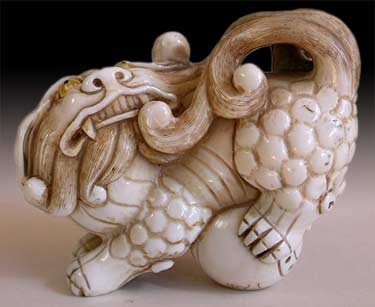
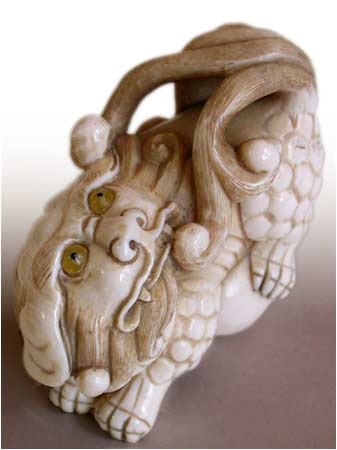
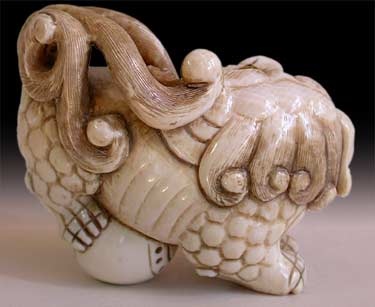
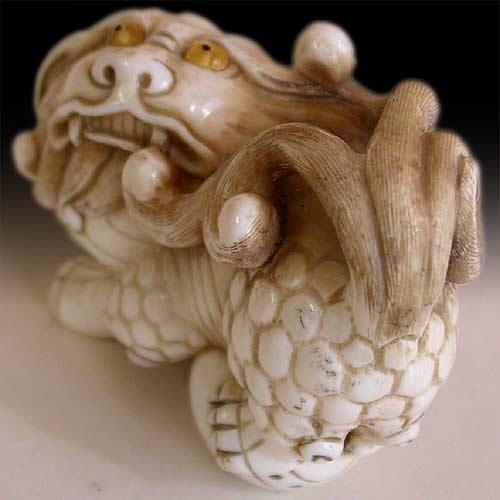

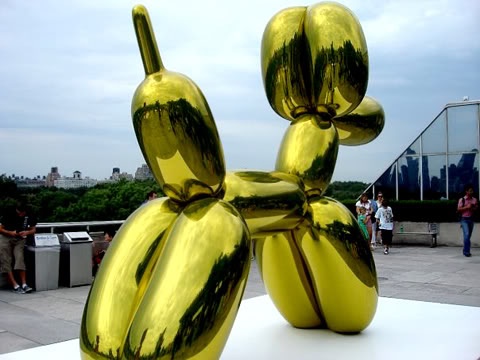
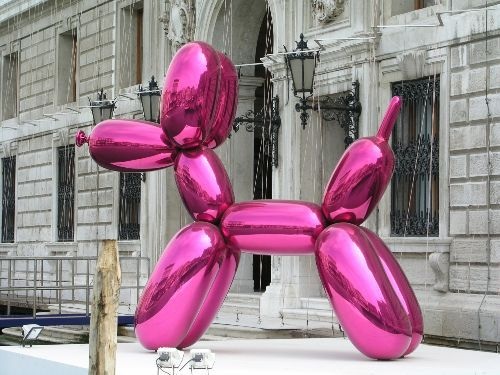
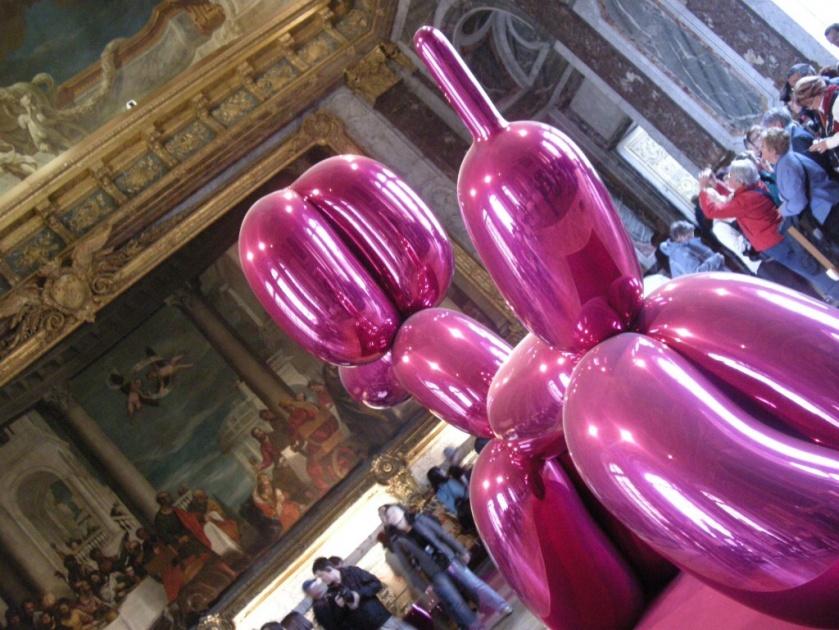
“The thirteenth property is the void, an empty space of silence. This is the only property that I do not see in the dog, so I leave it out.”
He’s staring into it. Seriously! The eyes are quite focused on a point up at some one/thing, and this also draws your eyes to it, but it’s nothing, since it’s an isolated sculpture.
LikeLiked by 3 people
beautiful
LikeLike
That creeps me out a lot in a mostly good way
LikeLike
I was introduced to Chris Alexander more than 35 years ago by a friend who was a cabinet maker and interested in beauty. I applaud the efforts, but there are enough exceptions and judgements that I’ve not kept track of Alexander recently.
While I mostly agree with the take-down of Koons’s dog [and the seemingly endless reproductions of it], I can’t say why I feel that way about the balloon, but find the mirror-pieces of Anish Kapoor compelling. “Sky Mirror” http://anishkapoor.com/230/Sky-Mirror.html for example, or “Cloud Gate” aka The Chicago Bean.
I think that the Kapoor pieces are installed to draw their beauty from the environment and the reflection of the viewer. The site-specificity of the Kapoor pieces sometimes brings this out. But some of them are mirrored surfaces in a gallery and not site-specific. There’s very little to them, but somehow they compel “viewing inward” in a way that the Balloon Dog doesn’t.
LikeLiked by 1 person
The mirrored surfaces in the Kapoor pieces are full of “centers” due to the reflections – each cloud or window of a building, for instance. The reflections in the balloon dog don’t form centers – they seem more like the unintentional reflection of a naked guy taking a picture of his teapot to sell it on ebay.
LikeLiked by 3 people
Also (I already said this to Barry) the Kapoor pieces are specifically designed (at least, as far as I can tell) to reflect their environment in ways that create many of the above things (maybe not all).
LikeLiked by 1 person
I have to confess to kind of liking the blue Koons balloon dog that I saw in the Corcoran in Washington, but it’s probably from thinking my kids would like it.
LikeLiked by 2 people
Maybe there ought to be a Metropolitan Museum of Clever Gimmicks. I would enjoy going there, but in a different spirit from going to an art gallery.
LikeLiked by 1 person
Koons’ art was never meant to be beautiful the same way decorative craftsmanship of the past was, hence this comparison feels a bit misguided, contemporary art leans heavily into concepts and context as opposed to trying to create visually beautiful things.
I enjoy thinking about these aspects but feel that beauty is hard to pin down in general. I can think of things I find beautiful that go against many of the properties listed here and I can also imagine designing things that exhibit these properties but still feel ugly.
LikeLike